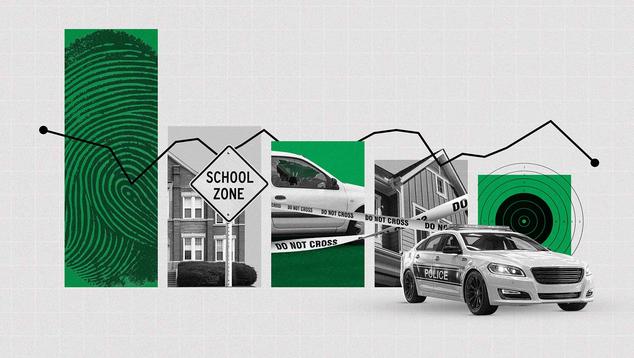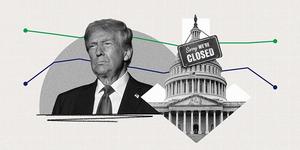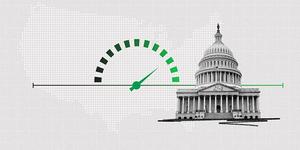Story Highlights
- 49% each view crime as a serious problem, and as increasing
- 31% afraid to walk alone at night in neighborhood, down from 40% in 2023
- Identity theft, financial scams, children being harmed at school top crime worries
WASHINGTON, D.C. — Building on last year’s less-negative assessments of crime in the U.S., Americans’ perceptions have again improved in 2025. Less than half, 49%, now say crime is an “extremely” or “very” serious problem in the U.S., and the same percentage say crime has increased in the past year. These readings are down seven and 15 percentage points, respectively, since last year and are at their lowest levels since at least 2018.
Both of these measures worsened after 2018, as perceptions of rising crime in the early 2020s hit levels last reached in the 1990s and views of the seriousness of crime hit a record-high 63%. The latest findings, from Gallup’s Oct. 1-16, 2025, annual Crime poll, show that Americans now view national crime conditions more favorably than at any point in recent years, returning to levels similar to the early 2000s.
In addition to the 49% of U.S. adults who currently think there is more crime in the U.S., 33% say there is less and 8% volunteer that there is about the same amount of crime. Besides the 17% of U.S. adults who think crime is “extremely” or 32% “very” serious, 38% say it is “moderately,” 8% “not too” and 2% “not at all” serious.
Views of National Crime Have Improved Among Most Subgroups Since 2023
Perceptions of crime as a problem in the U.S. and its trajectory in the previous year have improved across nearly all demographic subgroups since 2023.
In 2023, majorities of U.S. adults across party identification, gender, annual household income and type of community groups said the crime problem in the U.S. was at least very serious. Among those groups today, majorities of Republicans, women, those with annual household incomes under $40,000 and residents of rural areas say the same.
A similar pattern is seen in U.S. adults’ views of whether crime has increased in the past year, with one notable exception: Democrats have become more likely since last year to say there is more crime in the nation. This may be the result of the change from a Democratic to a Republican presidential administration, a pattern that has occurred in the past. That is, when Americans’ party matches that of the sitting president, they are generally less likely to report an increase in crime; and they are more likely to say crime is rising when the president hails from the other party. The latest data show a 36-point drop since 2024 in Republicans’ belief that crime is on the rise.
Views of Local Crime Also Improved
Americans have consistently seen crime in their local areas as less serious than crime in the country at large. That is still the case, and there have also been declines in perceptions that local crime is a serious problem and that it is increasing.
The 30% of Americans now reporting that there is more crime in their local area than a year ago is down 19 points since last year. Meanwhile, the 12% of Americans who say the crime problem in their local area is extremely or very serious is not significantly different from last year’s 14%, but it is down from the trend high point of 17% in 2023.
Fear of Walking Alone at Night in Local Area Continues to Decline
Another Gallup question on Americans’ perceptions of local crime gauges their comfort walking alone at night in the area where they live. This measure, which has been tracked since 1965, finds 31% of Americans currently reporting that there is an area within a mile of their home where they would be afraid to walk alone at night, and 68% saying there is not.
Two years ago, the percentage saying they were afraid to walk alone in a local area at night reached 40%, its highest point since 1993. Last year, it was at 35%; and now, it is just two points away from the trend low recorded in 2020.
Fear is notably higher on this measure among U.S. adults with lower incomes, those who live in cities, those in the Western region of the U.S. and women.
Worries About Crime Victimization Mostly Down
While Americans’ overall assessments of the nation’s crime situation have become more positive in recent years, so too have their fears about victimization on a variety of specific types of crime.
The public expresses less worry now than in the past few years about getting mugged, getting murdered, being sexually assaulted, having their car stolen or home burglarized. Worry about a child being physically harmed at school and Americans’ concern about being the victim of a hate crime are the only two that have not declined significantly.
Overall, Americans worry most about being the victim of identity theft (69%) and being tricked into providing financial information to scammers (53%). These are the only crimes included in the survey about which majorities say they worry frequently or occasionally.
Meanwhile, 43% of all U.S. adults worry about a school-aged child of theirs being physically harmed at school, but this rises to 60% of parents of school-aged children. Fewer Americans say they worry about crimes, such as having a car stolen (39%) or their home burglarized (34%), being a victim of a hate crime (30%), or getting mugged (29%), attacked while driving (27%), murdered (22%) or sexually assaulted (21%).
Among major demographic subgroups, gender remains the biggest differentiator in worry about crime. Women are significantly more worried than men about being sexually assaulted (by 34 points, 38% to 4%), having a child harmed at school (17 points, 51% to 34%), being tricked by a scammer (14 points, 60% to 46%) and being the victim of a hate crime (12 points, 36% to 24%).
Bottom Line
Americans’ views of crime in the U.S. have improved notably for the second straight year, reversing the pessimism seen earlier in the decade. Less than half now describe such crime as a very or extremely serious problem or believe it has risen in the past year.
Perceptions have brightened across nearly all demographic subgroups, and assessments of local crime have followed, as far fewer adults report increases in crime where they live and a growing share feel safe walking alone at night. These shifts mark a continued return to the more positive attitudes last seen in the early 2000s, suggesting the public sees national crime conditions stabilizing after several years of heightened unease. National crime statistics confirm Americans’ belief, as FBI data show a 4.5% decrease in U.S. crime in 2024.
Still, Americans’ improved assessments of national and local crime do not eliminate personal anxiety about victimization. Majorities of adults remain worried about being targets of financial crimes such as identity theft or scams, and parents continue to fear for their children’s safety at school.
Stay up to date with the latest insights by following @Gallup on X and on Instagram.
Learn more about how the Gallup Poll Social Series works. View complete question responses and trends (PDF download).




